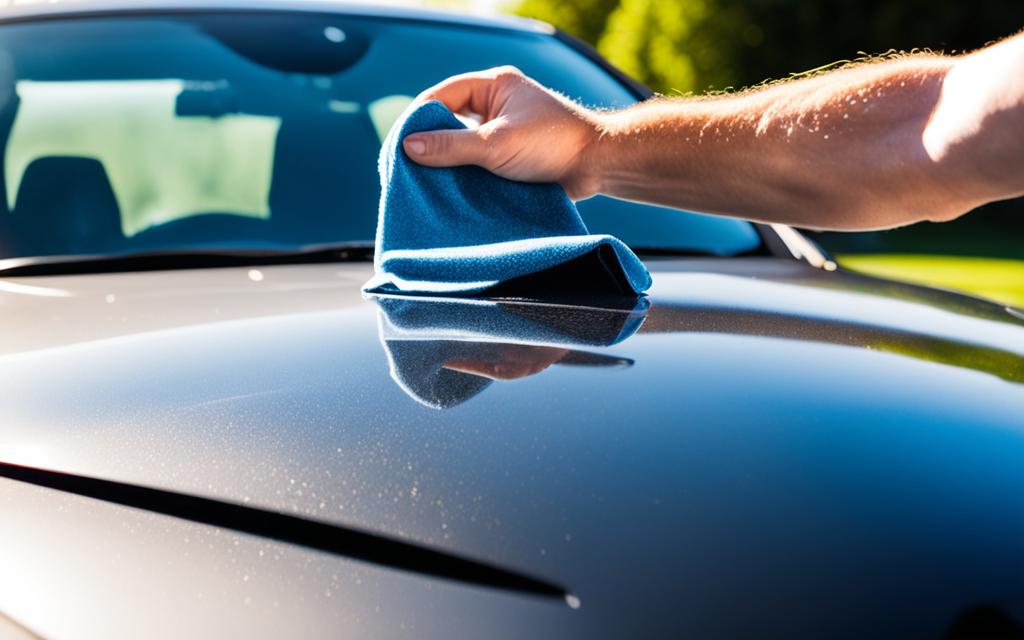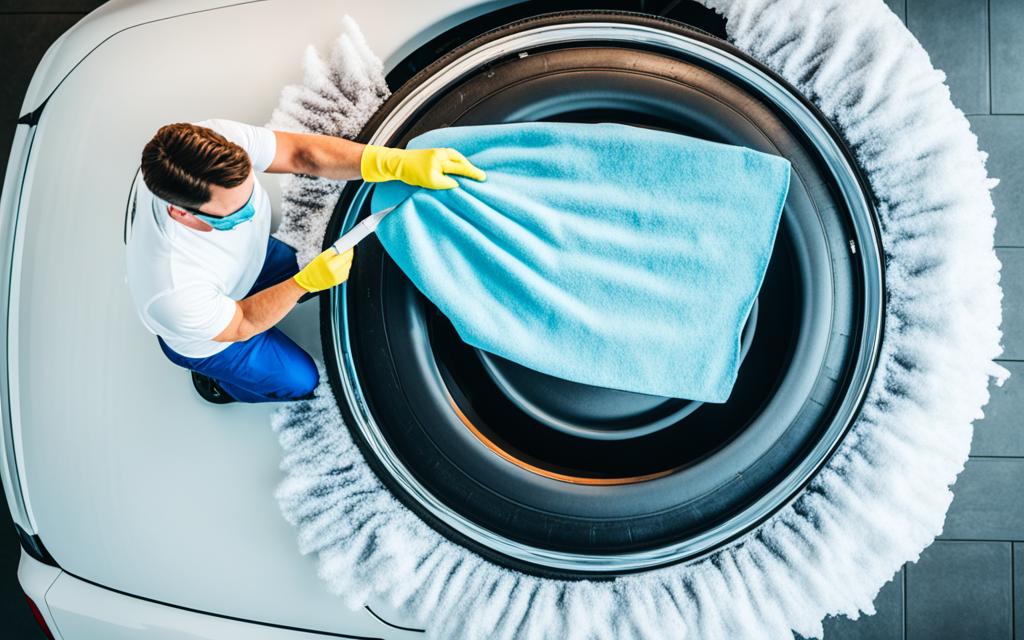Welcome to our comprehensive guide on how to wax a car like a professional. Whether you’re a beginner looking to master the basics or an experienced car enthusiast aiming for that showroom shine, we’ve got you covered.
Car waxing is more than just giving your vehicle a glossy finish. It’s an essential step in car care that helps protect the paint from harmful UV rays, oxidation, and environmental contaminants. Plus, it enhances the overall appearance of your car, making it look brand new.
In this guide, we’ll show you the best car waxing techniques, from applying wax by hand to using a machine for professional-grade results. You’ll also learn how to properly prepare your car, the importance of buffing and polishing, and how to maintain your waxed finish for long-lasting results.
Key Takeaways:
- Waxing your car not only enhances its appearance but also protects the paint from damage.
- Proper preparation is crucial for a successful waxing process.
- There are different techniques for applying wax, including by hand and with a machine.
- Buffing and polishing give your waxed finish that extra shine.
- Regular maintenance is necessary to preserve the longevity of your waxed finish.
Understanding the Benefits of Waxing Your Car
Before diving into the waxing process, let’s explore why waxing your car is crucial for maintaining its appearance and protecting the paint. Waxing not only enhances the aesthetic appeal of your car but also provides a barrier against harmful elements that can damage its exterior.
Here are some important benefits of regular car waxing:
- Enhanced Gloss and Shine: Waxing your car creates a smooth, reflective surface that enhances the shine and color of the paint, giving your vehicle a showroom appearance.
- Protection from UV Rays and Oxidation: The sun’s UV rays can cause the paint on your car to fade and oxidize over time. Wax acts as a barrier, blocking out UV rays and preventing damage to the paintwork.
- Reduced Scratches and Swirl Marks: Waxing fills in microscopic imperfections on the surface of your car, reducing the visibility of scratches and swirl marks.
- Water Repellent Properties: A layer of wax creates hydrophobic properties on your car’s surface, causing water to bead up and roll off, preventing watermarks and promoting easier cleaning.
- Protection against Environmental Contaminants: Wax acts as a protective shield, guarding your car against environmental contaminants such as dirt, dust, bird droppings, and tree sap.
Regular waxing is a simple yet effective way to preserve the beauty and value of your car. By dedicating a little time to maintaining the wax on your car, you can enjoy a stunning and well-protected vehicle for years to come.
Remember, car care is not just about aesthetics; it’s also about protecting your investment and ensuring that your car maintains its value over time.
In the next section, we will guide you through gathering the right tools and products to achieve professional-quality results when waxing your car.
Gathering the Right Tools and Products
When it comes to achieving professional-level results in car detailing, having the right tools and products is essential. Properly equipped, you’ll be well on your way to creating a stunning finish that will make your car stand out.
Let’s take a look at the essential supplies you’ll need for successful car detailing. We’ve also handpicked some of the best car wax products available in the market to help you achieve impressive results.
Essential Supplies for Car Detailing
Before diving into the waxing process, gather these essential supplies:
- A high-quality microfiber wash mitt for gentle yet effective cleaning.
- A pH-balanced car wash soap to remove dirt and grime without damaging the paint.
- Soft microfiber towels for drying and buffing.
- A clay bar kit to remove embedded contaminants and create a smooth surface.
- A dual-action polisher for more efficient application of wax and sealant.
- Various foam or microfiber applicator pads for even product distribution.
- A selection of car wax products, including paste wax, liquid wax, or spray wax.
- A high-quality carnauba wax for a deep, glossy finish.
- Protective gloves to keep your hands clean during the process.
Recommended Car Wax Products
While there are many excellent car wax products available, here are a few recommendations to consider:
| Car Wax Product | Features | Price |
|---|---|---|
| Meguiar’s Ultimate Liquid Wax | Provides long-lasting protection and an incredible shine. Easy to apply and remove. | $24.99 |
| Collinite Liquid Insulator Wax | Durable formula that can withstand harsh conditions and offer superior protection. | $21.99 |
| Turtle Wax ICE Spray Wax | Quick and easy application with impressive water repellency and UV protection. | $9.99 |
Remember, choosing the right car wax product depends on your preferences and the specific needs of your vehicle. Consider factors such as ease of application, durability, and desired finish when making your selection.
Now that you have the right tools and products, you’re ready to dive into the exciting world of car detailing. In the next section, we’ll guide you through the essential steps to prepare your car for waxing, ensuring optimal results.
Preparing Your Car for Waxing
Proper preparation is crucial to achieve a successful waxing process and ensure a long-lasting, glossy finish for your car. By following these step-by-step instructions, even beginners can effectively prepare their cars for waxing.
Step 1: Thoroughly Wash Your Car
Start by giving your car a thorough wash to remove any dirt, grime, or debris that could interfere with the waxing process. Use a high-quality car shampoo and a soft sponge or microfiber cloth to gently clean the surface of your car.
Pro Tip: Rinse your car thoroughly before washing to remove any loose dirt that could scratch the paint.
Step 2: Pay Attention to Detail
Take the time to clean every nook and cranny of your car, including the wheels, tires, and door jambs. Use a separate sponge or cloth for these areas to prevent transferring dirt or grease onto the rest of your car.
Pro Tip: A small detailing brush can help you reach tight spots and remove stubborn dirt.
Step 3: Remove Surface Contaminants
After washing, use a clay bar to remove any surface contaminants that may still be clinging to your car’s paint. This step is crucial for achieving a smooth surface for the wax to adhere to.
Pro Tip: Use a clay lubricant or quick detailer spray to prevent the clay bar from sticking to the paint and causing scratches.
Step 4: Dry Your Car Thoroughly
Before moving on to the waxing step, ensure that your car is completely dry. Water droplets can interfere with the wax application and result in an uneven finish. Use a microfiber drying towel or a leaf blower to remove any remaining moisture.
| Tools and Products Needed for Preparing Your Car for Waxing: |
|---|
| Car wash shampoo |
| Soft sponge or microfiber cloth |
| Separate sponge or cloth for wheels and door jambs |
| Detailing brush |
| Clay bar |
| Clay lubricant or quick detailer spray |
| Microfiber drying towel or leaf blower |
Once you’ve completed these preparation steps, your car is now ready for the waxing process. By properly cleaning and prepping your car, you’ll ensure that the wax adheres effectively to the paint, resulting in a stunning, long-lasting shine.
Applying Wax by Hand
Discover the art of applying wax by hand for a flawless finish. Hand waxing provides you with better control and allows you to achieve precise coverage on every inch of your car’s surface. Follow our step-by-step guide below to master the skill of DIY car waxing like a pro.
Step 1: Choosing the Right Wax
Before you start waxing your car, it’s essential to select the right wax for your specific needs. Consider factors such as the type of paint finish, climate conditions, and personal preferences. Here are three common types of car waxes:
- Paste Wax: Offers long-lasting protection and high shine but requires more effort to apply and remove.
- Liquid Wax: Provides convenience and ease of application, making it ideal for beginners.
- Spray Wax: Offers quick and easy application, perfect for touch-ups or maintaining a waxed surface between major waxing sessions.
Choose the wax that suits your car’s needs and ensure you have enough quantity to cover the entire surface.
Step 2: Preparing Your Car
Before you start applying wax, thoroughly wash your car to remove dirt, grime, and any previous wax residue. Dry the car completely to ensure a clean surface for the wax to adhere to. Additionally, inspect the car for any scratches, dents, or imperfections that may require attention before waxing.
Step 3: Applying the Wax
Now it’s time to begin the waxing process:
- Start with a small amount: Take a small dollop of wax on a foam applicator pad or a clean microfiber cloth.
- Work in small sections: Divide your car into manageable sections, such as the hood, roof, doors, and trunk. Apply the wax to one section at a time.
- Use circular motions: Apply the wax using small, circular motions to ensure even coverage. Apply light pressure, and work the wax into the paint surface.
- Let it dry: Allow the wax to dry according to the manufacturer’s instructions. This typically takes a few minutes.
- Remove the wax: Take a clean microfiber cloth and gently buff off the dried wax residue. Use light, sweeping motions to reveal the beautiful, glossy finish.
- Repeat the process: Move on to the next section of your car and repeat the above steps until you have waxed the entire vehicle.

Remember, consistency is key when applying wax by hand. Take your time, ensure even coverage, and pay attention to detail. The result will be a showroom-worthy shine that will turn heads wherever you go.
Using a Machine to Apply Wax
If you’re looking to take your car waxing to the next level, using a machine can provide professional-grade results. While applying wax by hand can be effective, a machine ensures even coverage and a more efficient process. Follow these techniques and safety precautions to achieve the perfect waxed finish.
Choosing the Right Machine
Before diving into the process, it’s important to select the right machine for your car waxing needs. There are two main types of machines: rotary and dual-action orbital polishers. Rotary polishers are powerful and best suited for experienced users, while dual-action orbital polishers are more user-friendly and suitable for beginners.
Consider the size and weight of the machine, as well as its speed settings and pad options. Opt for a machine that offers variable speed control, allowing you to adjust the RPM (revolutions per minute) to meet the specific requirements of your car and the type of wax being used.
Preparation is Key
Before using a machine to apply wax, it’s crucial to prepare your car’s surface properly. Begin by washing and drying your car thoroughly to remove any dirt, debris, or contaminants. Inspect the paint for any scratches or imperfections that may need to be addressed before waxing.
Next, mask off any sensitive areas such as rubber trim, badges, and emblems to avoid accidentally damaging them with the machine. Using painter’s tape or automotive masking tape, create a protective barrier around these areas.
Applying Wax with a Machine
When applying wax with a machine, it’s important to use the right pad and follow the correct technique to achieve optimal results. Here’s a step-by-step guide:
- Choose a foam or microfiber pad that’s specifically designed for machine waxing. Avoid using abrasive pads, as they can cause damage to your car’s paint.
- Apply a small amount of wax onto the pad. Be sure not to overload the pad, as this can lead to uneven application and excess product waste.
- Start the machine at a low speed and spread the wax evenly onto the car’s surface. Work on a small section at a time, overlapping each pass to ensure uniform coverage.
- Gradually increase the speed of the machine as you move to the next section, using gentle and controlled movements. The machine should glide smoothly over the surface.
- Continue this process until the entire car is fully waxed.
Remember to take breaks and inspect your progress regularly to ensure even coverage and address any areas that may require additional attention.
Safety Precautions
While using a machine can enhance the waxing process, it’s important to prioritize safety. Here are some safety precautions to keep in mind:
- Always wear protective eyewear and gloves to shield yourself from any potential debris or chemicals.
- Keep the machine’s cord and any loose clothing or accessories away from moving parts to prevent accidents.
- Work in a well-ventilated area to avoid inhaling fumes from the wax or polish.
Pros and Cons of Machine Waxing
| Pros | Cons |
|---|---|
| Provides even coverage | Requires a learning curve |
| Efficient and time-saving | Higher upfront cost for the machine |
| Reduces fatigue and strain on arms | May require additional accessories and pads |
| Suitable for large or heavily oxidized surfaces | Potential for accidental damage if not used properly |
By following the proper techniques and safety precautions, you can achieve professional-level results with a machine. However, it’s important to practice and gain experience to master the art of machine waxing.
Next, we’ll explore buffing and polishing techniques to further enhance the shine and gloss of your waxed finish.
“Using a machine can elevate your car waxing game, providing a level of precision and efficiency that’s hard to achieve by hand. With the right technique and safety measures, you’ll be able to create a showroom-worthy shine on your vehicle.”
Buffing and Polishing for that Extra Shine
To achieve an impeccable shine on your car’s waxed finish, proper buffing and polishing techniques are essential. This final step will enhance the gloss and depth of the wax, giving your vehicle an enviable showroom-worthy appearance.
When it comes to buffing and polishing, selecting the right products is crucial. Look for high-quality polishes and buffing pads that are specifically designed for automotive use. These products will help you achieve professional-level results and maximize the longevity of your waxed finish.
Here are some car detailing tips to guide you through the buffing and polishing process:
- Choose the appropriate polish: Different polishes are formulated for specific paint types and conditions. Be sure to select a polish that matches your car’s paint and addresses any specific imperfections, such as scratches or swirl marks.
- Start with clean and dry surfaces: Before applying the polish, ensure that your car’s surface is clean and free of any dirt, dust, or debris. A thorough wash and dry will provide a smooth canvas for the polish to work its magic.
- Apply the polish in small sections: Work on one section of the car at a time, applying a small amount of polish to the buffing pad. Use gentle, circular motions to spread the polish evenly, allowing it to penetrate the surface and address any imperfections.
- Use the correct buffing pad: Different types of paint may require different buffing pads. Consult the instructions provided with the polish to determine which pad is best suited for your car’s paint type. The right pad will ensure optimal performance and prevent any potential damage to the paint.
- Monitor the pressure: Apply light to moderate pressure when buffing the polish onto the surface. Avoid using excessive force, as this can lead to swirl marks or paint damage. Let the polish do the work for you.
- Work in small, overlapping sections: By working in small areas and overlapping your strokes, you’ll ensure thorough coverage and an even shine. Take your time and be patient to achieve the best results.
- Remove excess polish: Once you’ve finished buffing and polishing a section, use a clean, soft microfiber cloth to remove any excess polish residue. This will reveal the stunning shine underneath.
By following these car detailing tips, you’ll unleash the full potential of your waxed finish and maintain its brilliance over time. Remember to use proper technique, quality products, and a gentle touch to achieve the best results.

Maintaining Wax on Your Car for Long-lasting Results
Now that you’ve achieved a flawless, glossy finish on your car, it’s important to maintain the wax to preserve its longevity. Here are some essential tips for maintaining the wax on your car:
- Regularly wash your car: Dirt, dust, and environmental contaminants can degrade your wax over time. By washing your car regularly, you’ll remove these contaminants and prevent them from damaging the waxed finish.
- Use a pH-neutral car wash soap: Avoid harsh detergents or cleaners that may strip the wax. Opt for a pH-neutral car wash soap that is gentle yet effective in cleaning your vehicle.
- Apply quick detailers: Quick detailers are spray-on products that refresh and enhance the waxed finish. Use them between washes to rejuvenate the shine and provide additional protection.
- Protect your car from the elements: Exposure to sunlight, rain, and other environmental elements can degrade the wax over time. Whenever possible, park your car in a shaded area or use a car cover to shield it from the elements.
- Perform regular inspections: Take the time to inspect your car’s waxed finish periodically. Look for signs of wear, water spots, or oxidation. Address any issues promptly to maintain the integrity of the wax.
By implementing these car care tips, you’ll ensure that your waxed finish remains vibrant and protected for an extended period. Regular maintenance will not only enhance the appearance of your car but also extend the life and effectiveness of the wax.
Maintaining Your Waxed Finish
Once you’ve applied a fresh coat of wax to your car, it’s essential to take proper care of it to preserve its pristine appearance and protect your investment. Follow these car care tips to maintain the wax on your car and ensure a long-lasting, glossy finish.
Regular Washing
Regular washing is crucial to remove dirt, dust, and other contaminants that can accumulate on your car’s surface and degrade the wax. Use a gentle car wash soap and a soft sponge or microfiber cloth to avoid scratching the paint. Rinse thoroughly and dry with a clean, lint-free towel to prevent water spots.
Protect from the Elements
Exposure to harsh weather conditions can strip away the wax and damage your car’s paint. Whenever possible, park your car in a covered or shaded area to shield it from the sun’s UV rays, rain, snow, and bird droppings. Consider using a car cover for added protection.
Avoid Automatic Car Washes
While convenient, automatic car washes can be harsh on your car’s finish and may cause swirl marks or scratches. Opt for hand washing or touchless car washes that use high-pressure water jets to clean your car without physical contact.
Apply a Quick Detailer
To revive the shine and enhance the protective layer, use a quick detailer spray between regular waxing sessions. Quick detailers are easy to use and can remove light dirt and fingerprints, leaving your car looking clean and glossy.
Store Car Carefully
If you need to store your car for an extended period, take extra precautions to protect the waxed finish. Clean your car thoroughly, apply an extra layer of wax, and use a breathable car cover specifically designed for long-term storage.
Pro Tip: Regular maintenance and care will help extend the life of your waxed finish. Make it a habit to inspect your car for any signs of damage or contaminants and address them promptly.
By following these car care tips, you can keep your waxed finish looking its best and maintain that showroom shine for years to come. Remember, proper maintenance is key to preserving the beauty and protecting the paint of your beloved car.
Conclusion
Congratulations! You now have all the knowledge and techniques to wax your car like a pro. By following these steps and using the recommended products, you can achieve a stunning, long-lasting shine on your vehicle. Proper car waxing not only enhances the appearance of your car but also protects the paint from dirt, UV rays, and other harmful elements.
Remember, the key to a successful waxing process starts with proper car preparation. Thoroughly clean your car before applying wax to ensure the best results. Whether you choose to apply wax by hand or with a machine, always strive for even coverage and follow the recommended techniques.
Once you have achieved your desired waxed finish, it’s essential to maintain it properly. Regularly wash your car using a pH-neutral car shampoo and avoid using abrasive materials that could damage the wax. Additionally, consider topping up your wax coat periodically to maintain that glossy, showroom-worthy shine.
With the knowledge gained from this guide, you can now enjoy the benefits of professional car waxing and make your car the envy of the neighborhood. So go ahead, invest some time and effort in waxing your car, and witness the transformation it brings to your beloved vehicle!
FAQ
How often should I wax my car?
It is recommended to wax your car every three to four months to maintain its protective layer and glossy finish. However, this can vary depending on factors such as climate and usage. Regularly inspect your car’s surface for signs of diminished wax and reapply as needed.
Can I wax my car in direct sunlight?
It is best to avoid waxing your car in direct sunlight. High temperatures can cause the wax to dry too quickly, making it difficult to buff off and potentially leaving streaks. Find a shaded area or choose a cloudy day for optimal waxing conditions.
What type of wax should I use?
There are various types of car wax available, including paste wax, liquid wax, and spray wax. Each has its pros and cons. Paste wax provides a durable protective layer, liquid wax is easy to apply and remove, and spray wax offers a quick and convenient application. Consider your preferences and the specific needs of your car when choosing the right wax product.
Do I need to wash my car before waxing?
Yes, it is essential to thoroughly wash your car before waxing. Remove any dirt, debris, and contaminants from the surface to ensure that the wax adheres properly. Use a car wash soap, microfiber mitt, and plenty of water for a thorough cleaning.
Can I wax a newly painted car?
It is best to wait about 30 to 60 days after a new paint job before waxing your car. This allows the paint to cure fully. Waxing too soon can interfere with the curing process and may result in damage to the paint finish.
Can I wax plastic or rubber trim?
It is generally recommended to avoid waxing plastic and rubber trim on your car. Wax can leave a white residue on these surfaces and may be challenging to remove. To protect and restore plastic or rubber trim, use specialized products designed for those materials.
Can waxing remove scratches from my car?
Waxing can help minimize the appearance of fine swirl marks and light scratches, but it is not a solution for deep scratches or major paint damage. If you have significant scratches, it is best to consult a professional for proper repair and touch-up.
Should I wax my car’s windows?
No, it is not necessary nor recommended to wax your car’s windows. Wax can create a hazy film on the glass, affecting visibility. Instead, use a quality glass cleaner to keep your windows sparkling clean.








